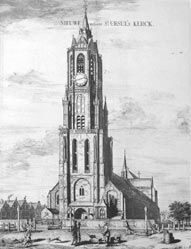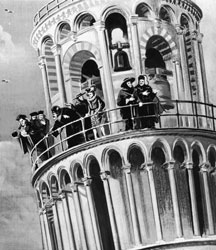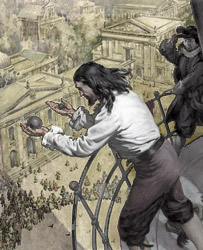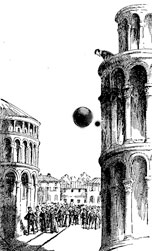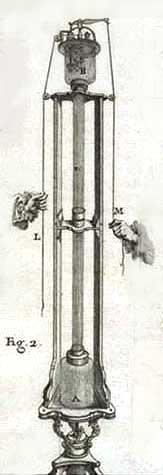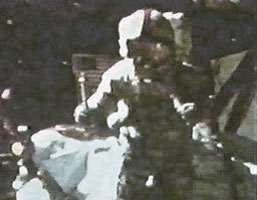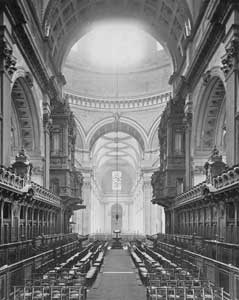to drop [to release an object in a gravitational field]:
scientific demonstrations and experiments
|
Borro, Moletti, Stevin
|
|
[The location as shown in Dirck van Bleyswyck: |
|
Pisa: Galileo, Coresio, Renieri
|
Vacuum: Boyle, Scott
|
|
|
Measurement: Mersenne, Hauksbee
|
|
In Paris around 1630, Marin Mersenne also carried out experiments with falling bodies. His letters show that these events functioned at the same time as demo's with "instantaneous peer review". "Truly I am astounded that you doubt my experience of the equal velocities of an iron ball and a wooden ball; for I only would have to ask the many persons of quality that saw and carried out the experiment with me to solemny swear, and they would bear true witness." [Letter to Jean Rey, 1 April 1632; cf. Caffarelli, 2009, p. 249.] After Galileo (1632) had published the principle of the uniform acceleration, Mersenne confirmed this hypothesis through quantitative measurements of falling times, using a pendulum to count the seconds. [Mersenne, 1636, p. 87; Cafarelli, 2009, p. 260.] More precise experiments, devised specifically to investigate the influence of air resistance on the velocities acquired by falling bodies, were carried out by Hauksbee (1710): "The first Experiment I made, was with two Balls:
One of them a thin glass Bubble, fill'd with Quicksilver; its Diameter 8 thenths of an Inch, and its Weight 840 Grains. The other Ball was a Cork, whose Diameter was 2 Inches two 10th, and its Weight 120 Grains. When these Balls were dropt, the Pendulum made 8 Vibrations, just as the Quicksilver Ball struck the Ground, and 8 more were repeated before the Cork arrived at the same place. [...] Isaac Newton was probably involved with these experiments. Without mentioning Hauksbee, he inserted some of the results in the second edition of his Philosophiae Naturalis Principia Mathematica. [Cf. Caffarelli, 2009, pp. 264-268.] |
References
Domenico Bertoloni Meli: Thinking with Objects. The Transformation of Mechanics in the Seventeenth Century. Baltimore: Johns Hopkins University Press, 2006. Hieronymus Borrius Arretinus: De Motu Gravium et Levium. Firenze, 1575. [Page numbers above refer to the second (1576) edition.] Roberto Vergara Caffarelli: "Galileo e Pisa." Lezione galileiana. Università di Cagliari, 1992. [Link to PDF] Roberto Vergara Caffarelli: Galileo Galilei and Motion. A reconstruction of 50 years of experiments and discoveries. Berlin: Springer, 2009. Lane Cooper: Aristotle, Galileo, and the Tower of Pisa. Ithaca: Cornell University Press, 1935. Giorgio Coresio: Operetta intorno al Galleggiare de Corpi Solidi. Firenze: Bartolommeo Sermartelli, 1612. I.E. Drabkin: English translation of Galileo's De Motu. In: Galileo Galiei: On Motion and On Mechanics. Madison: University of Wisconsin Press, 1960, pp. 13-114. Galileo Galilei: De Motu. Ms., ca. 1590. English translation by I.E. Drabkin in: On Motion and On Mechanics. Madison: University of Wisconsin Press, 1960, pp. 13-114. [The quote is from p. 107.] Francis Hauksbee: "Experiments concerning the Time required in the Descent of different Bodies, of different Magnitudes and Weights, in Common Air, from a certain Height." Philosophical Transactions, Oct.-Dec. 1710, pp. 196-198. W.R. Laird: The Unfinished Mechanics of Giuseppe Moletti. An Edition and English Translation of His Dialogue on Mechanics, 1576. Toronto: Toronto University Press, 2000, pp. 146-148. Marin Mersenne: Letter to Jean Rey, 1 April 1632. In: Correspondance. Vol. III. Paris, 1945, pp. 274-275. Marin Mersenne: Harmonie Universelle. Paris, 1636. Alberto A. Martínez: "Galileo and the Leaning Tower of Pisa." In: Science Secrets. Pittsburgh, PA: Pittsburgh University Press, pp. 1-12. Isaac Newton: Philosophiae Naturalis Principia Mathematica. Second Edition. 1713. Vincenzo Renieri: Letter to Galileo Galilei, 13 March 1641. [G.G. XVIII, p. 305.] M. Segre: "Galileo, Viviani, and the tower of Pisa." Studies in History and Philosophy of Science 20 (1989), pp. 435-451. Thomas B. Settle: "Galileo and early experimentation." In: R. Aris, H.T. Davis & R.H. Stuewer (eds.): Springs of Scientific Creativity. Essays on the Founders of Modern Science. Minneapolis: University of Minnesota Press, 1983, pp. 12-17. Simon Stevin: De Beghinselen des Waterwichts. Leyden, 1586. Vincenzo Viviani: Racconto istorico della vita di Galileo. Letter to Leopold de Medici, 1654. [I translate from page 275 of a German version: "Lebens-Beschreibung Galilæi Galilæi." In: Christoph August Heumann (ed.): Acta philosophorum, Vol. 3, 1723/1724, pp. 261-282, 400-423, 467-484.] Emil Wohlwill: "Galilei-Studien, 1. Die Pisaner Fallversuche." Mitteilungen zur Geschichte der Medizin und der Naturwissenschaften 4 (1905), pp. 229-248. |
Remko Scha, 2011
